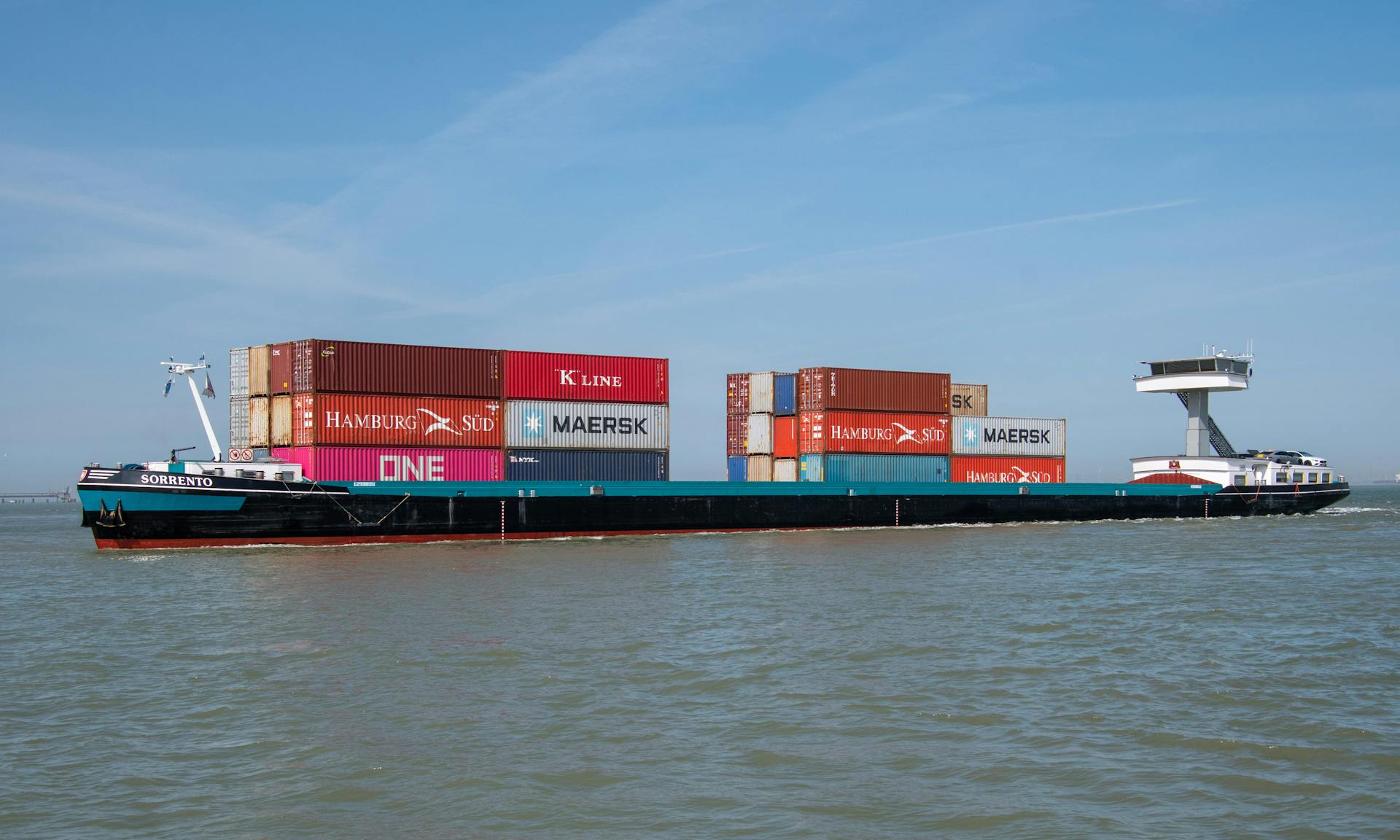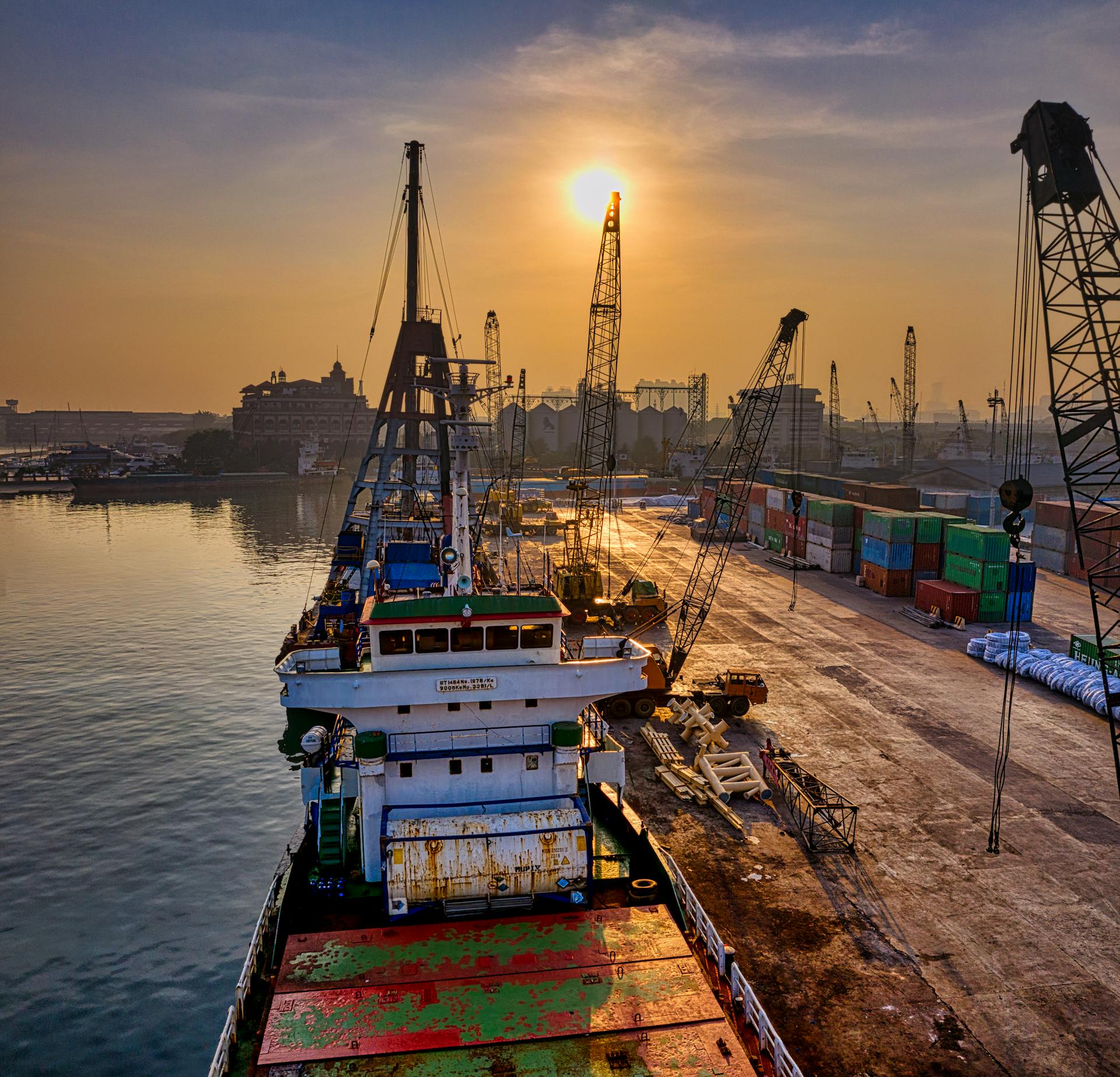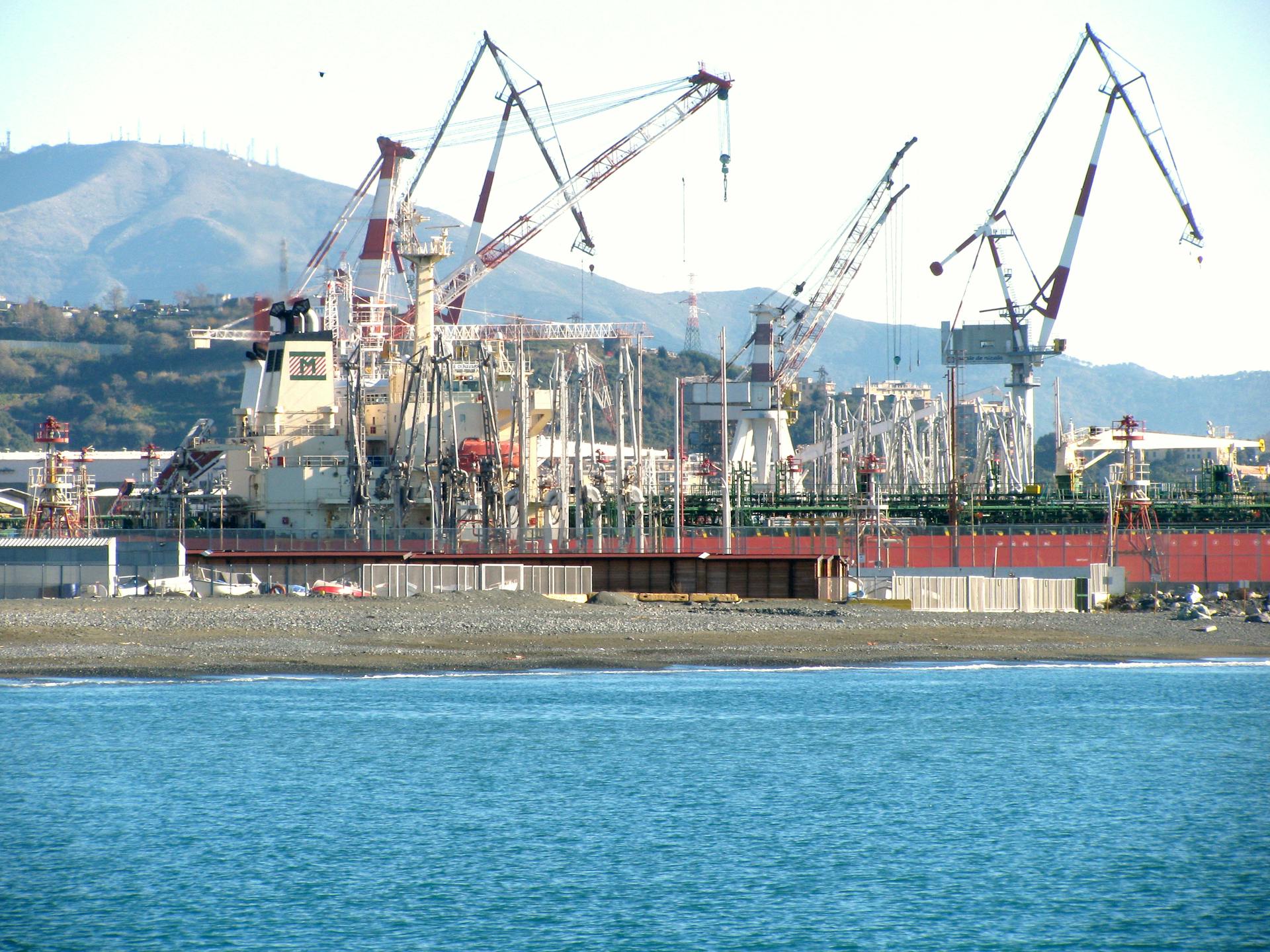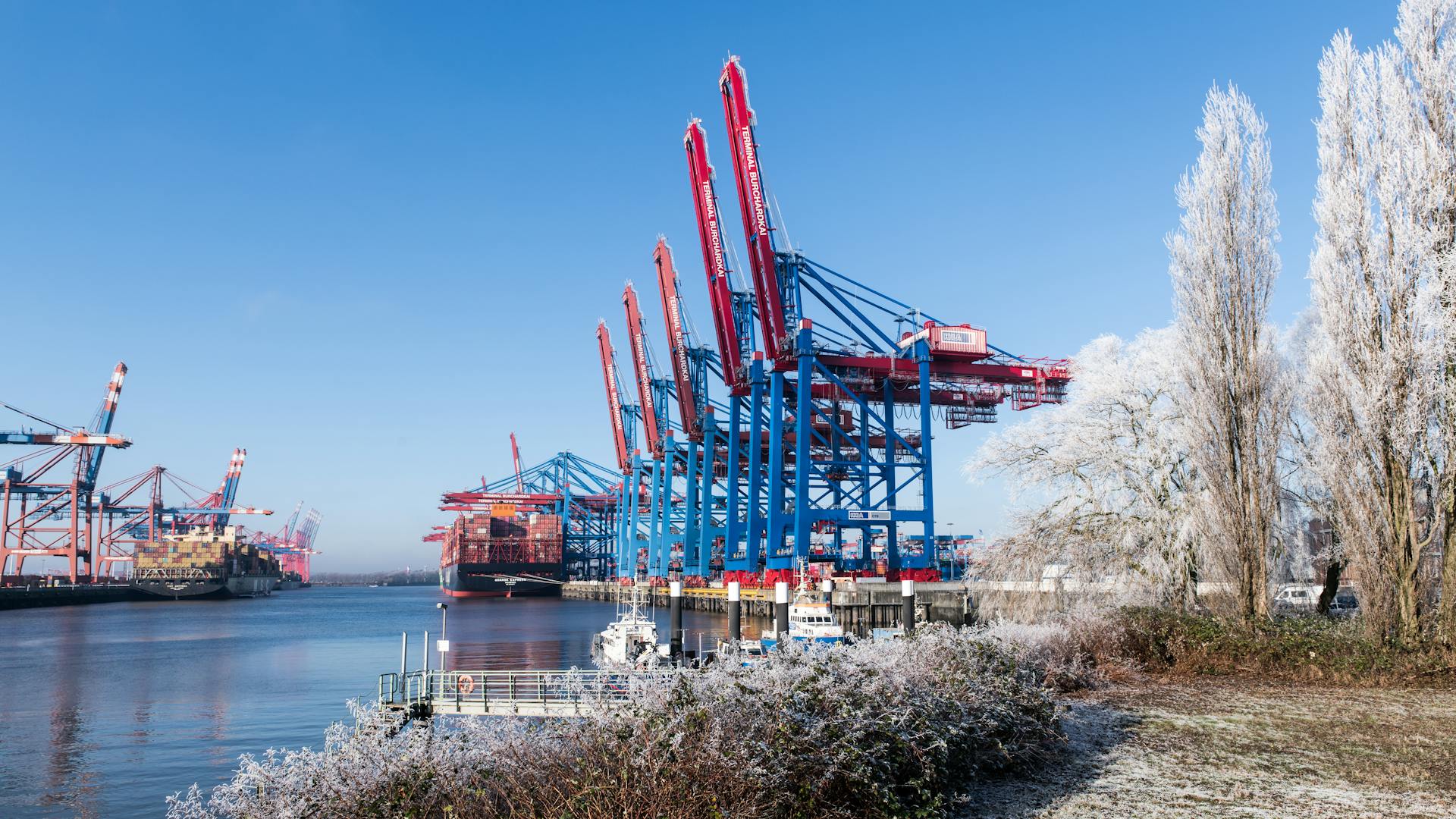
The size of a ship is a crucial factor in determining how many containers it can hold. The largest container ships can be over 400 meters long and 60 meters wide.
The average capacity of a modern container ship is around 14,000 to 15,000 twenty-foot equivalent units (TEUs). A TEU is a standard unit of measurement for container ships.
Container ships come in a range of sizes, from small feeder ships that can hold around 1,000 TEUs, to massive ultra-large container ships that can carry over 24,000 TEUs.
What is TEU?
A TEU, or Twenty Foot Equivalent Unit, is a standard container size used in shipping. It's 20 feet long, 8 feet wide, and 8 feet tall, with a volume of 1,280 cubic feet.
A ship's TEU capacity is the number of these containers it can carry, and it's a crucial factor in determining how much cargo a ship can hold. This capacity is carefully calculated to ensure the ship stays within its weight limits and meets safety regulations.
A ship with a TEU capacity of 5,000 can transport 5,000 20-foot containers, equating to a staggering 6,400,000 cubic feet of cargo space.
You might like: How Do Shipping Containers Lock Together
TEU Definition

A TEU, or Twenty Foot Equivalent Unit, is a standard measurement used to calculate the capacity of container ships. Each TEU represents a container that is 20 feet long, 8 feet wide, and 8 feet tall, with a volume of 1,280 cubic feet. This size is the standard for most containers.
A ship's TEU capacity is determined by the number of these containers it can carry. For example, a ship with a TEU capacity of 5,000 can transport 5,000 20-foot containers.
The volume of a ship's cargo space can be calculated by multiplying its TEU capacity by the volume of a single TEU. For instance, a ship with a TEU capacity of 5,000 has a cargo space volume of 6,400,000 cubic feet.
Here's a breakdown of the key factors that influence a ship's TEU capacity:
- Ship Size: Bigger ships can hold more containers.
- Container Size: Containers usually come in two sizes, 20-foot (TEU) and 40-foot (FEU).
- Ship Design: The ship’s design, including its deck and storage areas, affects how many containers it can load.
- Weight Distribution: Properly distributing the weight of the containers is important to keep the ship balanced and stable during the trip.
Container Ship Capacity
Container ships come in various sizes, with the largest ones able to carry thousands of containers on a single trip. The capacity of these ships is measured in TEUs, which stands for Twenty-foot Equivalent Units.

Most containers are 20 feet long, but some are 40 feet long, equivalent to two TEUs. This allows for different sizes of cargo to be transported while keeping things simple for global shipping.
A ship's TEU capacity determines how much cargo it can carry. For example, a ship with a TEU capacity of 10,000 can carry 10,000 containers that are each 20 feet long.
Here's a breakdown of the different types of container ships and their typical TEU capacities:
- Small Feeder Ships: 1,000 to 3,000 TEUs
- Panamax Ships: 5,000 TEUs
- Post-Panamax Ships: 8,000 to 12,000 TEUs
- Ultra-Large Container Vessels (ULCVs): over 21,000 TEUs
The largest container ships in the world are truly massive, with the current record holder, the Evergreen Alot, having a maximum TEU capacity of 24,004 units. These ships are built for maximum cargo capacity, allowing shipping companies to transport more goods while making fewer trips.
On a similar theme: Cargo Ship Container Capacity
Largest Cargo Ships
The largest cargo ships in the world can carry a staggering number of containers. Modern container ships can carry between 10,000 to 21,000 TEUs (twenty-foot equivalent units).

Evergreen Alot, the biggest cargo ship in the world, has a maximum TEU capacity of 24,004 units. This is a theoretical maximum capacity, and it doesn't mean the ship carries that volume on every trip.
Container ships come in various sizes, from small feeder ships that carry between 1,000 to 3,000 TEUs, to Ultra-Large Container Vessels (ULCVs) that carry over 21,000 TEUs. The size of a cargo ship determines how much cargo it can carry, with the biggest ships able to carry thousands of containers at once.
The largest container ships are over 366 meters in length, with some reaching 400 meters. These massive vessels are the most cost-effective for long-distance routes, making them a crucial part of global trade.
Here's a breakdown of the different types of container ships and their capacities:
- Small Feeder Ships: 1,000 to 3,000 TEUs
- Panamax Ships: 5,000 TEUs
- Post-Panamax Ships: 8,000 to 12,000 TEUs
- Ultra-Large Container Vessels (ULCVs): over 21,000 TEUs
Shipping Operations
Shipping operations are complicated and involve careful planning, scheduling, and loading of cargo onto ships.
The size of the ship is a huge factor in how much cargo it can carry, with larger ships able to hold more goods.

Weight limits are a key consideration when loading cargo, as exceeding them can compromise the ship's stability.
Larger ships can carry thousands of containers, but the actual number depends on the ship's size and the types of containers used.
Special cranes are used in ports to quickly move containers on and off the ship during the loading and unloading process.
Efficient shipping operations are crucial for getting products to the market on time and keeping international trade running smoothly.
Readers also liked: Double Door Shipping Containers
Factors Influencing Capacity
A ship's capacity to hold containers is influenced by several key factors.
Ship size is a major factor, with bigger ships able to carry more containers. In fact, the largest container ships can hold up to 24,346 containers, making them some of the most efficient ships for international trade.
Container size also plays a role, with most containers being 20 feet long and measured in TEUs (Twenty-foot Equivalent Units). A ship's capacity is often measured in TEUs, making it easy to understand its carrying capacity.
You might enjoy: China International Marine Containers

Ship design is another important factor, with the ship's deck and storage areas affecting how many containers it can load. Properly distributing the weight of the containers is also crucial to keep the ship balanced and stable during the trip.
Here are the key factors that influence a ship's capacity:
- Ship size: Bigger ships can hold more containers.
- Container size: Containers are usually 20 feet long and measured in TEUs.
- Ship design: The ship's deck and storage areas affect how many containers it can load.
- Weight distribution: Properly distributing the weight of the containers is important for stability.
Overview
Shipping containers come in various sizes, including 20-foot, 40-foot, and 45-foot containers, which are the most common.
The largest container ships can carry over 24,000 containers, with some vessels holding as few as 4,000 containers.
These massive ships are designed to traverse the world's oceans, often traveling across multiple continents to deliver goods.
A single 40-foot container can hold up to 45,000 pounds of cargo, which is roughly the weight of 20-25 cars.
Shipping containers are made of durable materials, including steel and aluminum, to withstand the rigors of transportation.
For your interest: How Many Cbm in 40 High Cube Container
Frequently Asked Questions
Can a cargo ship carry 20,000 containers?
A cargo ship can carry around 10,000 to 12,000 40-foot containers, which is roughly half its total TEU capacity. The exact number depends on the ship's size and equipment.
How many 40ft containers can a ship hold?
A modern cargo ship can hold up to 12,000 40-foot containers, equivalent to 6,000 standard 20-foot containers. This is based on a ship's capacity of around 24,000 TEUs.
Sources
- https://www.packsend.com.au/blog/how-many-shipping-containers-can-fit-on-a-ship/
- https://onsitestorage.com/how-many-shipping-containers-can-fit-on-a-container-ship/
- https://vocal.media/futurism/how-many-containers-fit-on-a-cargo-ship
- https://www.billiebox.co.uk/how-many-containers-fit-on-a-ship/
- https://www.linkedin.com/pulse/how-many-shipping-containers-can-fit-ship-fos-desk-tgfye
Featured Images: pexels.com


